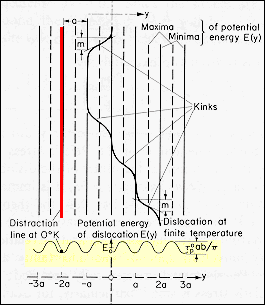|
The
energy of a dislocation depends on its position in its slip plane. The
diagram represents a slip plane with a position dependent potential having
a period, a, determined by the location of rows of atoms in the slip plane.
In order to minimize the free energy of the material it is desirable for
the dislocation to occupy a potential minimum (bold lines) in the slip
plane. In order for the dislocation to move on the slip plane, it must
overcome the potential maximum (dashed lines) between these local minima.
The difference in potential energy between the minimum and maximum is the
Peierls barrier to dislocation motion.
At
low temperatures the dislocation will tend to lie within a single potential
minimum on the slip plane (red line). Thermal fluctuations in the lattice
at high temperatures assist dislocations in overcoming the Peierls barrier
and they may develop kinks, rather than being in one potential minimum.
The black dislocation line in the diagram has several such kinks. |
|
|
|
